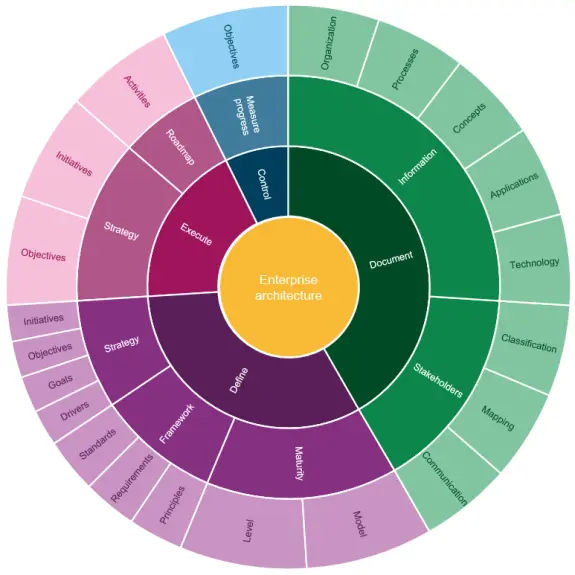To reinforce the process of implementing Enterprise Architecture in an existing organization, I developed an Enterprise Architecture Implementation Wheel.
The Enterprise Architecture Implementation Wheel is built around the central circle, Enterprise Architecture.
- The first ring around the center is the ring that defines the four main stages of the Implementation Wheel. Each stage consists of one or more steps.
- The steps form the second ring around the center circle and provide valuable information on how to approach each stage. The steps also define a number of key focus areas that are relevant to these steps.
- The key focus areas are presented in the third and final ring around the center circle. Each of the key focus areas details the various architectural deliverables that can be created to complete the previously mentioned steps.
The wheel should be read clockwise, starting from the inside out.
The image below is interactive. You can click on the various slices (parts) to learn more about that specific part.

Enterprise Architecture Implementation Wheel
The Wheel distinguishes four main stages. Each stage consists of one or more steps. Each step in turn consists of a number of key focus areas. The four stages and the associated steps are based on and inspired by the TOGAF® Standard. They can therefore be mapped to the phases of the Architecture Development Method (ADM).
Going through the four stages can help build a solid basic Enterprise Architecture. This does not mean that each stage and its steps must be followed to the letter. Every organization is different, and some organizations or situations require a different way of working. The method should therefore be seen primarily as a source of inspiration, but it can provide guidance at the start of an Enterprise Architecture implementation.
More information about the Implementation Wheel can be found in Chapter 8 of my book.
The four stages
Stage one: Document, is the first stage of the Enterprise Architecture Implementation Wheel.
The stage consists of the following steps:
Read more about Stage one: Document.
